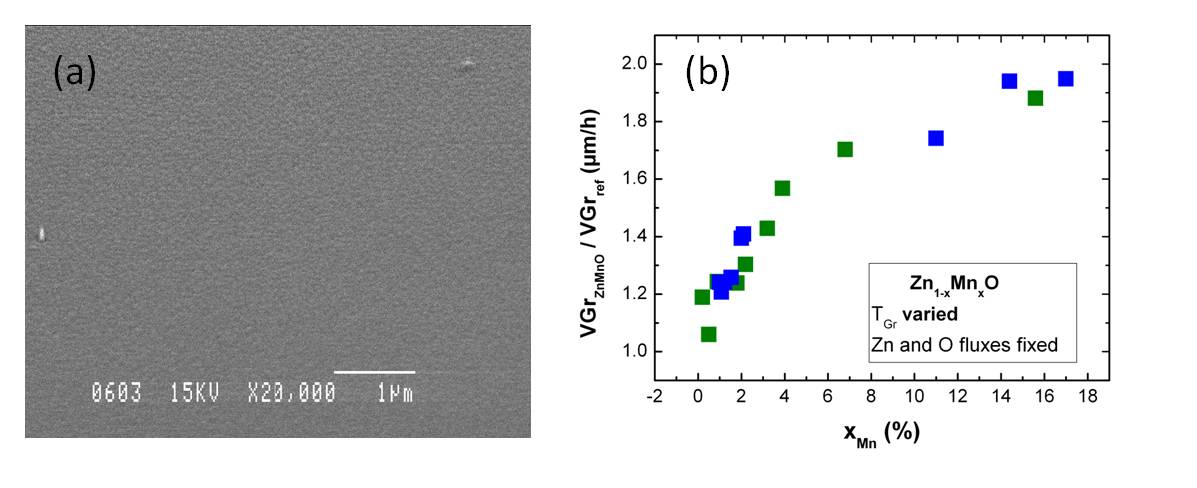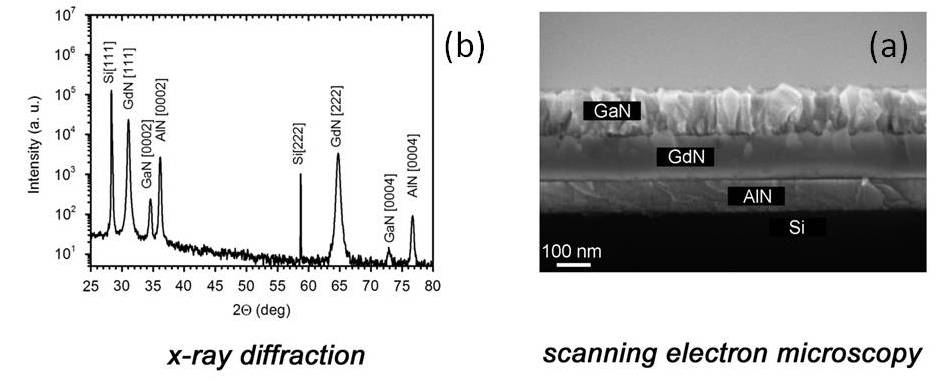| Recent publications :
|
|---|
⋄ Reflectivity and Photoreflectivity Spectra of Structures with Quantum Wells Based on ZnOA.M. Klyuev, N.G. Filosofov, A. Yu Serov, V.F. Agekyan, C. Morhain, V.P. Kochereshko |
⋄ Excitons in ZnO Quantum WellsM.N. Bataev, N.G. Filosofov, A. Yu. Serov, V.F. Agekyan, C. Morhain, V.P. Kochereshko |
1) Diluted magnetic semiconductors based on ZnO
Heterostructures based on ZnMnO / ZnO and ZnCoO / ZnO are studied at CRHEA as basic bricks for an all-oxide spintronic. During the epitaxy of these materials by Molecular Jets Epitaxy (MBE) certain peculiarities were observed, such as the effect of "smoothing" during the incorporation of Co, FIG. 4a, or the catalytic effect of Mn on the decomposition of oxygen. This latter effect is clearly evidenced by a significant increase in the growth rate of ZnMnO relative to the binary material. For the magneto-optical studies, these heterostructures were manufactured on sapphire substrates, orientation a and c, as well as on massive ZnO substrates. In addition, quantum wells have been introduced to exalt the magnetic effects associated with the presence of Mn or Co. atoms.

2) Rare earth nitrides
In the field of spintronics, several types of architectures have been proposed: ferromagnetic metal / semiconductor, dilute magnetic semiconductors, or magnetic semiconductors. The activity developed at CRHEA aims to manufacture and characterize heterostructures based on rare earth nitrides (NTRs). NTRs have the particularity, at low temperature, of being both a semiconductor and magnetic compound. In the laboratory, the elaboration of the NTRs is obtained using a molecular beam epitaxy (MBE) frame, Riber 32p. NTRs crystallize in the cubic structure of sodium chloride (NaCl) and are therefore binary compounds between a member of the lanthanide column and a nitrogen atom. The materials developed at CRHEA are samarium nitride (SmN) and gadolinium nitride (GdN), which have remarkable electrical and magnetic properties. The evaporation of the rare earths Gd and Sm is carried out using an effusion cell. The atomic nitrogen can come either from a precursor gas, ammonia (NH3), but can also be obtained by catalytic effect between molecular nitrogen and lanthanides (in this case Gd and Sm). The scanning electron microscope image (Fig. 2 (a)) shows an example of an epitaxial layer developed by EJM on an AlN trench layer on silicon (111). The NTR thicknesses are of the order of 100-200 nm, whereas the GaN encapsulation layer makes it possible to passivate the NTRs, since they have the disadvantage of being very reactive in contact with the air. . As illustrated by the diffractograms of Figure 2 (b), the materials thus obtained are monocrystalline, which illustrates the interest of the EJM for the development of this sector.

| Recent publications
|
|---|
⋄ Enhanced Sm spin projection in GdxSm1−xNJ. D. Miller, J. F. McNulty, B. J. Ruck, M. Al Khalfioui, S. Vézian, M. Suzuki, H. Osawa, N. Kawamura, and H. J. Trodahl |
⋄ Experimental and ab initio study of Mg doping in the intrinsic ferromagnetic semiconductor GdNC.-M. Lee, J. Schacht, H. Warring, H. J. Trodahl, B. J. Ruck, S. Vézian, N. Gaston, and F. Natali |


